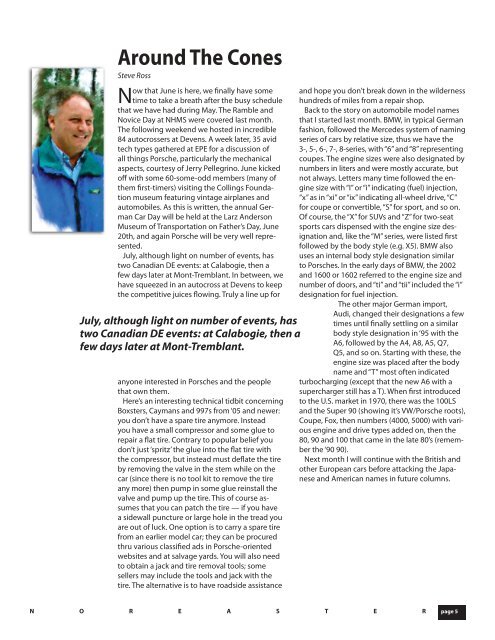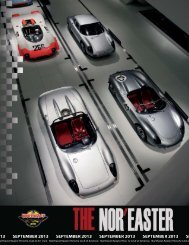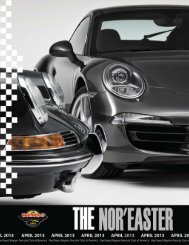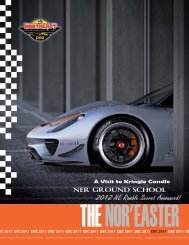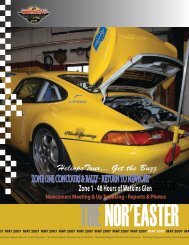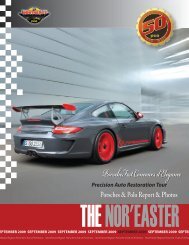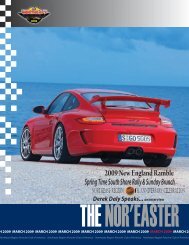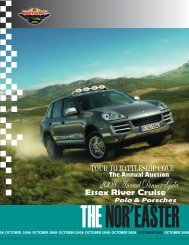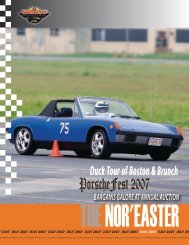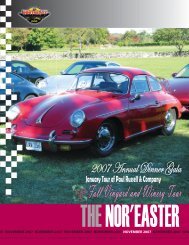July - Porsche Club of America â Northeast Region
July - Porsche Club of America â Northeast Region
July - Porsche Club of America â Northeast Region
Create successful ePaper yourself
Turn your PDF publications into a flip-book with our unique Google optimized e-Paper software.
Around The Cones<br />
Steve Ross<br />
Now that June is here, we finally have some<br />
time to take a breath after the busy schedule<br />
that we have had during May. The Ramble and<br />
Novice Day at NHMS were covered last month.<br />
The following weekend we hosted in incredible<br />
84 autocrossers at Devens. A week later, 35 avid<br />
tech types gathered at EPE for a discussion <strong>of</strong><br />
all things <strong>Porsche</strong>, particularly the mechanical<br />
aspects, courtesy <strong>of</strong> Jerry Pellegrino. June kicked<br />
<strong>of</strong>f with some 60-some-odd members (many <strong>of</strong><br />
them first-timers) visiting the Collings Foundation<br />
museum featuring vintage airplanes and<br />
automobiles. As this is written, the annual German<br />
Car Day will be held at the Larz Anderson<br />
Museum <strong>of</strong> Transportation on Father’s Day, June<br />
20th, and again <strong>Porsche</strong> will be very well represented.<br />
<strong>July</strong>, although light on number <strong>of</strong> events, has<br />
two Canadian DE events: at Calabogie, then a<br />
few days later at Mont-Tremblant. In between, we<br />
have squeezed in an autocross at Devens to keep<br />
the competitive juices flowing. Truly a line up for<br />
<strong>July</strong>, although light on number <strong>of</strong> events, has<br />
two Canadian DE events: at Calabogie, then a<br />
few days later at Mont-Tremblant.<br />
anyone interested in <strong>Porsche</strong>s and the people<br />
that own them.<br />
Here’s an interesting technical tidbit concerning<br />
Boxsters, Caymans and 997s from ‘05 and newer:<br />
you don’t have a spare tire anymore. Instead<br />
you have a small compressor and some glue to<br />
repair a flat tire. Contrary to popular belief you<br />
don’t just ‘spritz’ the glue into the flat tire with<br />
the compressor, but instead must deflate the tire<br />
by removing the valve in the stem while on the<br />
car (since there is no tool kit to remove the tire<br />
any more) then pump in some glue reinstall the<br />
valve and pump up the tire. This <strong>of</strong> course assumes<br />
that you can patch the tire — if you have<br />
a sidewall puncture or large hole in the tread you<br />
are out <strong>of</strong> luck. One option is to carry a spare tire<br />
from an earlier model car; they can be procured<br />
thru various classified ads in <strong>Porsche</strong>-oriented<br />
websites and at salvage yards. You will also need<br />
to obtain a jack and tire removal tools; some<br />
sellers may include the tools and jack with the<br />
tire. The alternative is to have roadside assistance<br />
and hope you don’t break down in the wilderness<br />
hundreds <strong>of</strong> miles from a repair shop.<br />
Back to the story on automobile model names<br />
that I started last month. BMW, in typical German<br />
fashion, followed the Mercedes system <strong>of</strong> naming<br />
series <strong>of</strong> cars by relative size, thus we have the<br />
3-, 5-, 6-, 7-, 8-series, with “6” and “8” representing<br />
coupes. The engine sizes were also designated by<br />
numbers in liters and were mostly accurate, but<br />
not always. Letters many time followed the engine<br />
size with “I” or “i” indicating (fuel) injection,<br />
“x” as in “xi” or “ix” indicating all-wheel drive, “C”<br />
for coupe or convertible, “S” for sport, and so on.<br />
Of course, the “X” for SUVs and “Z” for two-seat<br />
sports cars dispensed with the engine size designation<br />
and, like the “M” series, were listed first<br />
followed by the body style (e.g. X5). BMW also<br />
uses an internal body style designation similar<br />
to <strong>Porsche</strong>s. In the early days <strong>of</strong> BMW, the 2002<br />
and 1600 or 1602 referred to the engine size and<br />
number <strong>of</strong> doors, and “ti” and “tii” included the “i”<br />
designation for fuel injection.<br />
The other major German import,<br />
Audi, changed their designations a few<br />
times until finally settling on a similar<br />
body style designation in ‘95 with the<br />
A6, followed by the A4, A8, A5, Q7,<br />
Q5, and so on. Starting with these, the<br />
engine size was placed after the body<br />
name and “T” most <strong>of</strong>ten indicated<br />
turbocharging (except that the new A6 with a<br />
supercharger still has a T). When first introduced<br />
to the U.S. market in 1970, there was the 100LS<br />
and the Super 90 (showing it’s VW/<strong>Porsche</strong> roots),<br />
Coupe, Fox, then numbers (4000, 5000) with various<br />
engine and drive types added on, then the<br />
80, 90 and 100 that came in the late 80’s (remember<br />
the ‘90 90).<br />
Next month I will continue with the British and<br />
other European cars before attacking the Japanese<br />
and <strong>America</strong>n names in future columns.<br />
N O R E A S T E R page 5


